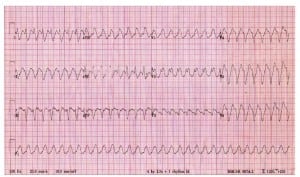| Author | Affiliation |
|---|---|
| Amandeep Singh, MD | Alameda County Medical Center – Highland General Hospital |
An 83-year-old male with known coronary artery disease presented to our emergency department (ED) with a complaint of palpitations and associated minor chest discomfort while on his way to play a round of golf. Vital signs were significant for a blood pressure at 122/76 mmHg, heart rate at 180 beats per minute, respiration rate at 20 breaths per minute, temperature at 37°C, and SpO2 at 98% on room air. A 12-lead ECG showed a wide-complex tachycardia with no clearly discernible P waves and was thought to represent monomorphic ventricular tachycardia. Initial treatment with procainamide was attempted; however, within minutes of receiving this medication, his blood pressure dropped to 70/40 mmHg. Procedural sedation using etomidate and fentanyl, followed by electrical synchronized cardioversion using a biphasic defibrillator at 200J, successfully converted his rhythm to a sinus rhythm.
The differential diagnosis for a wide-complex (i.e. QRS 0.12sec) regular tachycardia with no clearly discernible P waves prior to each QRS complex includes ventricular tachycardia, supraventricular tachycardia with preexisting or rate-related bundle branch block (e.g. SVT with LBBB), and supraventricular tachycardia with antidromic conduction through an accessory pathway (e.g. antidromic WPW). Several proposed criteria may aid in the differentiation of these entities.1,2 Contemporary teaching, however, mandates that a wide-complex tachycardia should be presumed ventricular tachycardia if the diagnosis is ambiguous. 3

Footnotes
Supervising Section Editor: Rick A. McPheeters, DO
Submission history: Submitted November 8, 2007; Revision Received January 26, 2008; Accepted February 2, 2008
Full text available through open access at http://escholarship.org/uc/uciem_westjem
Address for Correspondence: Amandeep Singh, MD, Department of Emergency Medicine, Alameda County Medical Center, 1411 East 31st Street, Oakland, CA 94602
Email: asingh27@gmail.com
Conflicts of Interest: By the WestJEM article submission agreement, all authors are required to disclose all affiliations, funding sources, and financial or management relationships that could be perceived as potential sources of bias. The authors disclosed none.
REFERENCES
1. Brugada P, Brugada J, Mont L, Smeets J, Andries EW. A new approach to the differential diagnosis of a regular tachycardia with a wide QRS complex. Circulation. 1991;83:1649–1659. [PubMed]
2. Vereckei A, Duray G, Szenasi G, Altemose GT, Miller JM. Application of a new algorithm in the differential diagnosis of wide-QRS complex tachycardia. Eur Heart J.2007;28:589–600. [PubMed]
3. Zipes DP, Camm AJ, Borggrefe M, et al. ACC/AHA/ESC 2006 guidelines for management of patients with ventricular arrhythmias and the prevention of sudden cardiac death: a report of the American College of Cardiology/ American Heart Association Task Force and the European Society of Cardiology Committee for Practice Guidelines. Circulation. 2006;114:e385–e484. [PubMed]


